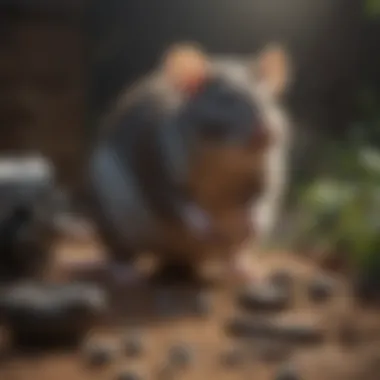Proven Strategies to Keep Rats Out of Your Home


Intro
Rats inhabit diverse environments, from urban areas to rural settings. Their prevalence poses significant challenges for homeowners. It is crucial to understand their biology, behavior, and how they thrive in various habitats. This knowledge lays the groundwork for effective strategies to keep these pests at bay.
Fascinating Facts About the Animal
Unique Characteristics
Rats belong to the family Muridae, which includes the common brown rat (Rattus norvegicus) and the black rat (Rattus rattus). These rodents have remarkable adaptability. They can thrive in almost any environment if adequate food and shelter are available. A single rat can reproduce multiple times a year, leading to rapid population growth.
Extraordinary Abilities
One of the remarkable features of rats is their intelligence. They can navigate complex mazes and exhibit problem-solving skills. Rats also possess a strong sense of smell and can detect food sources from considerable distances. This ability makes them more challenging to deter once they infest a home.
Behavior and Habitat
Natural Habitats
Rats typically prefer dark, secluded areas for nesting, such as basements, attics, and crawl spaces. They are nocturnal creatures, more active during the night. Common nesting sites include cluttered spaces and places with easy access to food sources. Understanding these natural tendencies can help homeowners implement effective strategies.
Social Structures
Rats often live in colonies, displaying strong social behaviors. They communicate through vocalizations and pheromones. Social hierarchies exist within these colonies, with dominant individuals often leading the way to resources. This social structure influences their behavior and can complicate extermination efforts.
Recent Scientific Discoveries
Latest Research Findings
Recent studies indicate that rats have intricate social networks. These findings show that when one rat discovers a food source, they often share this information with their peers. This tendency emphasizes the need for comprehensive preventative measures when trying to eliminate potential food sources at home.
Breakthroughs in Animal Biology
Research has also highlighted the link between urban environments and rat populations. As cities expand, so does habitat for these rodents. Understanding this relationship can assist city planners and homeowners in developing strategies to mitigate rat infestations effectively.
Cultural Significance
Animals in Folklore
Rats are often depicted as symbols of pestilence and danger in various cultures. Folklore portrays them in both negative and positive lights, illustrating the complex relationship humans share with these creatures. This duality further highlights the need for informed approaches to managing their populations.
Influence on Art and Literature
Rats have influenced literature and art across centuries. They appear in works from different civilizations, often as a representation of decay or survival. This cultural significance underscores the persistent presence of rats in human history, reinforcing the need for effective strategies to manage their populations today.
Understanding the biological behavior of rats and their cultural significance helps in devising effective deterrent strategies.
By synthesizing this information about rats, homeowners can become more proactive. This involves using knowledge to create unwelcoming environments in their homes, thereby reducing the likelihood of rat infestations.
Understanding Rat Behavior
Understanding rat behavior is crucial for effectively deterring these pests from your home. By familiarizing oneself with the factors that attract rats, their preferred habitats, and the signs they leave behind, homeowners can devise targeted strategies to keep them at bay. This knowledge not only aids in prevention but also prepares individuals to respond swiftly if an infestation occurs.
What Attracts Rats to Homes
Rats are drawn to our homes for several reasons. Key attractants include:
- Food Sources: Leftover food, pet food, or even garbage can entice rats. They have keen senses and can detect food from a distance.
- Shelter Options: Rats seek warm, safe places to nest. Cluttered areas, attics, and basements serve as ideal habitats.
- Water Accessibility: Just like any living being, rats need water. Leaking pipes or standing water can be significant attractants.
Homeowners need to minimize these attractants to discourage rats from entering. Simple practices such as proper food storage, regular cleaning, and water leak repairs can be very effective.
Common Rat Habitats and Nests
Rats prefer certain environments over others. They can typically be found in:


- Urban Areas: Cities provide ample food and shelter, making them hot spots for infestation.
- Around Garbage: They thrive near waste bins and compost heaps, where food is easily accessible.
- Indoor Settings: Inside homes, they often nest in walls, behind appliances, and in basements or crawl spaces.
Identifying potential nesting sites can aid in prevention. Regular inspections of these areas can help ensure that they are rat-free.
Signs of Rat Infestation
Detecting a rat problem early is vital. Key indicators include:
- Droppings: Fresh droppings are usually a sign of active infestation. Rat droppings are easy to identify and can often be found in areas where they frequent.
- Gnaw Marks: Rats need to gnaw on materials to wear down their continuously growing teeth. Look for bite marks on wood, wires, or packaging.
- Nest Materials: Shredded papers, fabric, or insulation can be signs of nesting activity.
- Noises: Scratching sounds at night can indicate activity in walls or attics.
Recognizing these signs can enable prompt action before a small problem escalates into a large infestation.
Understanding these behaviors and signs equips homeowners with the knowledge to effectively monitor and deter rat populations. A proactive approach can significantly reduce the risk of infestations.
Health and Safety Risks
Understanding the health and safety risks associated with rats is essential for any homeowner. These pests not only threaten the structural integrity of your living environment but also pose several health hazards. By recognizing the dangers rats bring, one can take proactive measures to keep their homes safe and healthy.
Diseases Transmitted by Rats
Rats are known carriers of numerous diseases which can be transmitted to humans. Some of the notable diseases include:
- Leptospirosis: This bacterial disease can infect humans through contact with water or soil contaminated by rat urine. Symptoms include fever, chills, and muscle aches and, if untreated, can lead to more severe complications.
- Salmonella: Often transmitted via contaminated food or surfaces, rats can carry salmonella bacteria which can cause gastrointestinal distress. Ingestion of contaminated food can lead to severe sickness.
- Hantavirus: This is a serious disease transmitted through rodent droppings, urine, or saliva. It can cause severe respiratory issues in humans, and in some cases, it can be fatal.
Understanding these health implications emphasizes the necessity of effective rodent control measures. It is crucial to educate family members about potential risks, especially if there are young children or pets in the home who may come into contact with contaminated surfaces.
Damage Caused by Rat Infestations
Beyond health risks, rats can cause significant physical damage to properties. These damages can escalate repair costs and possibly even compromise the safety of a home. The following points highlight ways in which rats can wreak havoc:
- Structural Damage: Rats have powerful incisors that allow them to gnaw through wood, plastic, and even soft metals. This can weaken the structural integrity of your home and lead to costly repairs.
- Electrical Damage: Chewing on electrical wiring is a common occurrence among rats. This creates a fire hazard, posing serious danger to occupants. Homeowners should be particularly vigilant in areas with wiring and insulation.
- Contamination of Food Products: Rats can contaminate food supplies, leading to significant waste and loss. Their droppings, urine, and fur can spoil food, making it unsafe for consumption.
“Addressing health and safety risks not only protects your house but also ensures that your family remains safe from potential threats associated with rat infestations.”
By taking the time to understand these health and safety risks, proactive measures can be taken to minimize both the likelihood of infestations and the associated dangers that come with them.
Preventing Rat Intrusion
Preventing rat intrusion is a critical component of maintaining a safe and healthy home environment. Rats are notorious for their ability to infiltrate homes and cause significant damage while posing health risks to residents. Addressing potential entry points and minimizing attractants plays a vital role in effective rat management. By focusing on prevention, homeowners can reduce the likelihood of an infestation, preserving their properties and peace of mind.
Sealing Entry Points
Identifying Vulnerable Areas
Identifying vulnerable areas around the home is essential in the fight against rat intrusion. Common entry points include gaps around pipes, vents, and doors. Rats can squeeze through spaces as small as a quarter of an inch. Recognizing these weak spots contributes significantly to preventing future infestations. A well-sealed household provides a strong defense against these pests. The primary benefit of this strategy lies in its simplicity; however, diligence is necessary to ensure thorough inspection.
Some unique aspects of identifying vulnerable areas include regular maintenance checks and a comprehensive inspection of the exterior. Homeowners often overlook areas such as basements and garages. Inadequate attention can lead to unnoticed entry points that rats exploit.
Materials for Effective Sealing
The materials used for sealing entry points must be durable and resistant to gnawing. Steel wool, caulk, and hardware cloth are effective options. Steel wool can be stuffed into holes and combined with caulk, creating an impenetrable barrier. The importance of selecting the right materials cannot be understated, as they play a crucial role in long-term rat repulsion.
An advantage of steel wool is its flexibility and ease of application. Homeowners can mold it into various shapes to fit different gaps. However, it is essential to replace it periodically, as it can deteriorate over time. Proper sealing materials ensure a proactive approach to rat prevention.
Proper Food Storage Techniques
Choosing Rat-Proof Containers
Choosing rat-proof containers is vital in reducing food sources available to rats within a home. Containers made from tough plastic or glass with secure lids can effectively deter rats from accessing your food supplies. By utilizing such containers, homeowners mitigate the risks associated with food contamination and illness.
A notable characteristic of rat-proof containers is their ability to resist gnawing, making them a popular choice for food storage. Furthermore, many options these days come with airtight seals, reducing odors that may attract rats. It is essential to select containers that have been specifically designed to withstand rodent intrusion.
Unique features may include stackable designs, making organization easier. However, the cost of high-quality rat-proof containers can be higher than traditional storage options.
Cleaning and Maintenance of Storage Areas


The cleaning and maintenance of storage areas is another significant aspect of preventing rat infestations. Regularly cleaning pantries, cupboards, and food storage areas minimizes potential food sources that attract rats. It is equally important to dispose of any expired or unused food products promptly.
A key factor in maintenance is establishing a regular cleaning schedule. By doing this, homeowners can keep their storage areas organized and devoid of food debris. Using vacuum cleaners and disinfectants helps eliminate crumbs and spills that may lure rats.
While cleanliness may seem like an obvious solution, it requires ongoing effort. Failure to adhere to good cleaning practices can quickly lead to infestations.
Landscaping to Discourage Rats
Choosing Appropriate Vegetation
Choosing appropriate vegetation can make a significant difference in preventing rat habitation in your outdoor spaces. Selecting plants that do not produce seeds, nuts, or fruits minimizes food sources for rats. Some options include ornamental grasses and shrubs that provide minimal cover or attracts rodents.
The key characteristic of well-planned vegetation is its role in discouraging rats while enhancing the aesthetic appeal of a property. Poor vegetation choices can provide attractive habitats for rats, complicating control efforts.
A unique feature is the ability of some plants to thrive in various climates without creating dense undergrowth, which can hide rats. However, homeowners must remain vigilant in their choices, as certain plants may unintentionally provide food and shelter.
Maintaining Clean Outdoor Spaces
Maintaining clean outdoor spaces is essential to complement efforts in preventing rat infestations. This includes regular yard cleaning, eliminating clutter, and ensuring waste bins are secure. Tidiness helps remove potential nesting sites for rodents, making your yard less attractive to rats.
An important aspect of cleanliness is its direct impact on overall pest control. By keeping outdoor spaces organized, you create an uninviting environment for rats.
The unique advantage of maintaining clean outdoor spaces is its contribution to a more pleasant living environment. However, some homeowners may find regular upkeep time-consuming, especially if poorly maintained spaces require extensive cleaning efforts.
Effective prevention is predicated on understanding rat behaviour and adapting your living spaces accordingly.
Utilizing Deterrents
Utilizing deterrents is crucial in the comprehensive battle against rats in residential areas. These strategies focus on creating an environment that discourages rats from intruding. This section explores various deterrent methods, highlighting their benefits and effective applications.
Chemical Repellents
Chemical repellents serve as a formidable barrier against rat infestations. These products often contain strong scents or substances that rats find offensive. When applied properly, chemical repellents can create a hostile environment that keeps rats at bay. It is essential to choose a repellent that is safe to use around pets and children. One common characteristic of these repellents is their long-lasting effectiveness. However, it is important to consider their impact on the surrounding environment, especially if used outdoors, as some chemicals may affect local wildlife. Therefore, always follow the manufacturer’s instructions and consider potential consequences when using these products.
Natural Deterrents
Natural deterrents present an appealing alternative for those seeking a more eco-friendly approach. Many homeowners prefer substances like peppermint oil, garlic, or vinegar. These natural ingredients can be strategically placed around the home to repel rats without introducing harsh chemicals. The key benefit of natural deterrents is their safety for both humans and pets, making them suitable for use in kitchens or play areas. However, the effectiveness of natural options can vary, and they may require more frequent application compared to chemical alternatives. This aspect is worth considering when planning your deterrent strategy.
Mechanical Devices
Ultrasonic Repellents
Ultrasonic repellents are a modern solution gaining popularity among homeowners. These devices emit high-frequency sound waves that are inaudible to humans but disturb rats. This disturbance encourages them to leave the area. The attraction of ultrasonic repellents lies in their ease of use and installation. They are also considered a humane choice, as they do not harm the animals. Nevertheless, the effectiveness of ultrasonic devices may fluctuate based on room size and obstacles that could block the sound waves, so placement is crucial.
Trap Options
Trap options are often a primary consideration when addressing rat infestations. Various types of traps are available, including snap traps, electronic traps, and catch-and-release traps. Each type has its characteristics and efficiency levels. Snap traps are popular for their quick action and ease of use. Electronic traps provide a more humane approach, killing rats instantly without physical contact. In contrast, catch-and-release traps allow homeowners to relocate captured rats, yet they require monitoring and can involve more effort. When selecting a trap, it's essential to evaluate not only the likelihood of effectiveness but also the ethical implications and ease of handling.
Choose deterrents that best fit your lifestyle and preferences, always prioritizing safety and effectiveness.
Sanitation Practices
Sanitation practices play a crucial role in preventing rat infestations. Cleanliness helps reduce the likelihood of attracting rats to your home. When homes are kept clean, there are fewer food sources available for these pests. Furthermore, proper sanitation minimizes potential nesting sites for rats. Adopting good hygiene habits is not just about cleanliness; it is a preventive measure that directly impacts home safety and comfort.
Keeping Areas Clean
Regular Cleaning Schedules
Establishing regular cleaning schedules is fundamental in maintaining a rat-free environment. This practice contributes significantly to the overall goal of discouraging rodent habitats. One key characteristic of regular cleaning schedules is consistency. When areas are clean and tidy, it becomes challenging for rats to find food or shelter.
A unique feature of these schedules is the ability to adapt to seasons or changing activities in the household. For example, during larger gatherings, extra care should be taken to clean up thoroughly afterward. The advantages of having a regular cleaning schedule include routine cleanliness, accountability among household members, and a noticeable reduction in clutter that might attract rats.
Disposing of Waste Properly


Properly disposing of waste is vital for keeping rats at bay. It contributes directly to the goal of minimizing attractants that may lure these pests. The key characteristic of proper waste disposal is timeliness. Trash should be removed regularly and not left to accumulate. An important aspect is to use appropriate waste bins with secure lids, which will reduce odors attracting rats.
The unique feature of waste disposal practices is how they often involve multiple steps, such as recycling and composting. However, the disadvantage may include the need for diligence and effort, which some may overlook. In this article, effective waste disposal methods can greatly enhance your surroundings and deter rats.
Handling Pet Food
Storing Pet Food Securely
Securing pet food is vital for effective rat deterrence. It prevents easy access to potential food sources that could attract unwanted guests. The key characteristic of storing pet food securely is using airtight containers. These containers minimize odor and limit easy access for rodents.
Storing pet food in secure ways is a beneficial choice because it not only protects the food from pests but also keeps it fresh. A unique aspect is that many airtight containers are designed for ease of use, making it simple for pet owners to refill and access food when needed. However, some containers may be bulky or require extra space.
Feeding Pets Responsibly
Feeding pets responsibly is another critical aspect of proper pet food handling. This practice can significantly impact the broader goal of reducing rat attraction. A key characteristic of this approach is portion control. By only feeding pets what they need, scraps are less likely to be left outside.
The unique feature of responsible feeding includes timed feeding routines, which limit the chances of uneaten food sitting out and attracting rats. The advantage of this method is a reduction in waste, but the downside could be the need for training pets to adhere to set feeding times. By implementing these practices, homeowners can greatly discourage rats from becoming a concern.
Maintaining sanitation practices is essential for a sustainable rat-free home. Proper habits and behaviors lead to safe living environments.
Monitoring for Signs of Return
Monitoring for signs of rat return is crucial for maintaining a home free of infestations. Once initial action is taken, vigilance becomes necessary to ensure that the efforts employed do not yield temporary results. Rats can be resolute in their behavior, and proactive monitoring allows homeowners to identify any signs of their presence before full-blown infestations occur again. This section discusses key strategies for regular inspections and effective use of monitoring tools.
Regular Inspections
Regular inspections are a fundamental practice to detect any signs of rats re-entering your space. This entails a systematic check of both indoor and outdoor areas. Key focus points during inspections include:
- Entry Points: Examine doors, windows, and any gaps in walls for potential access areas.
- Food Sources: Ensure that food is stored properly and that no crumbs or spills are present. Rodents are agile and can return if food sources remain accessible.
- Droppings: Look for fresh droppings as these indicate active infestations. The presence of droppings often indicates that rats are present or have recently taken shelter.
- Nests: Check for signs of nesting materials such as shredded paper or fabric hidden in corners, attics, or basements.
- Grease Marks: Rats often leave oily marks on surfaces they frequently navigate. These can be particularly prevalent along walls or on ledges.
Conduct these inspections at least once a month to stay ahead of potential problems. Consider keeping a log of findings. This record can help identify patterns and highlight areas that may require additional attention.
Using Monitoring Tools
Employing monitoring tools can significantly enhance the capability to detect returning rats. Various devices and technologies are available, each suited for unique circumstances.
- Camera Systems: Use motion-detection cameras to capture movement in areas where rat activity is suspected. This method allows for real-time monitoring and can reveal time patterns of rat movement.
- Smart Traps: These electronic traps not only capture rats but can also send alerts to your mobile device upon catching one. Smart technology provides a modern approach to tracking rodent activity.
- Sticky Traps: While more traditional, sticky traps continue to serve as effective means to ascertain the presence of rats. Place them near walls or suspected entry points. Regularly inspect them to check for captures.
- Scent Tracking Devices: Some solutions use scent markers that attract rats, allowing for better monitoring of their movement.
Utilizing these methods combined with regular inspections helps create a comprehensive approach to monitoring. The goal is to allow homeowners to detect the slightest hint of rat activity and take action swiftly. This proactive strategy reduces potential health risks and protects the home from damage.
“Regular monitoring is as important as prevention. A rat problem often starts with a single rat – catching it early can save significant damage and health issues later.”
When to Seek Professional Help
Knowing when to call for help is crucial when dealing with rat infestations. Homeowners sometimes underestimate the severity of the problem. Rats reproduce quickly and can cause serious damage if not dealt with promptly.
It is essential to recognize that a small number of sightings can quickly escalate into a larger infestation. Seeking professional assistance can save time and reduce risks associated with handling the situation yourself. Pest control experts possess the knowledge and tools to effectively manage such infestations.
Identifying the Extent of Infestation
Determining how extensive a rat infestation is requires attention to specific signs and behaviors. Look for droppings, gnaw marks, and nests in hidden areas.
New evidence may appear in places such as:
- Kitchen: Droppings near food sources and gnaw marks on packaging.
- Basement: Signs of nesting materials like shredded paper or fabric.
- Attics: Noises at night can indicate rats are active.
Record your observations. Knowing where and how often you see these signs helps professionals understand the problem's scale.
Remember: An untreated infestation can cause greater health risks and property damage.
Choosing a Pest Control Service
Selecting the right pest control service is vital. Research different companies and assess their methods. Look for those that prioritize integrated pest management—this ensures focused efforts on sanitation and prevention alongside elimination.
When evaluating potential services:
- Check Reviews: User testimonials often show effectiveness in handling rat issues.
- Ask About Techniques: Ensure they use humane and eco-friendly methods.
- Evaluate Certifications: Licensed professionals bring credibility and expertise.
Consider discussing your specific situation before hiring. This conversation can reveal their understanding and provide insight into their approach. A good service should adapt to your unique needs and concerns.
Pest control is not just about removing rats. It is about establishing a long-term solution to ensure these intruders do not return.







